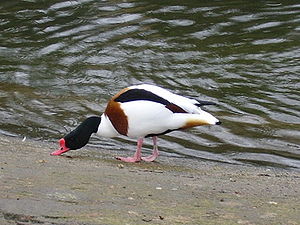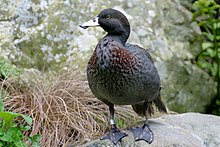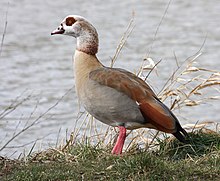Half geese
| Half geese | ||||||||||
|---|---|---|---|---|---|---|---|---|---|---|

Shelduck ( Tadorna tadorna ) |
||||||||||
| Systematics | ||||||||||
|
||||||||||
| Scientific name | ||||||||||
| Tadorninae | ||||||||||
| Reichenbach , 1850 |
The half geese (Tadorninae) are a subfamily of the duck birds . They got their name because many typical representatives mediate between geese and "real" ducks . Today, however, some clearly duck-like representatives are counted among the demi-geese, because more detailed morphological or genetic analyzes have shown their relationship to the actual demi-geese.
The three recent tribes of demi-geese include very different types of ducks. The Merganettini are located at the base of the half geese; They include river and sea-dwelling ducks from South America and New Zealand. The Plectropterini comprise three goose-like birds that were previously settled in the disintegrated taxon of the glossy ducks and are also mainly native to the southern hemisphere. The majority of the species, on the other hand, belong to the Tadornini tribe, the "real" demi-geese, to which such well-known species as the shelduck and the Egyptian goose are counted.
distribution
Demi-geese are found almost all over the world, but most species occur in subtropical or temperate climates. They are completely absent in North America. Basically, half geese only occur at low altitudes. The mirror geese and the blue-winged goose, which occur in the high mountains of the tropics, are an exception . Apart from the steamship ducks and the kelp goose , they live in fresh or brackish waters and only use sheltered sea bays in coastal areas.
Tribus Merganettini: torrent, sock-billed and steamship ducks
In 1986 the zoologist Bradley C. Livezey was the first to assume a relationship between the three externally very different genera. This assumption is based on anatomical similarities of the metacarpus . The position of the three taxa in relation to the half geese is by no means certain. Some authors also consider it possible to belong to the swimming ducks.
The northern-billed duck is an endemic New Zealand bird that is adapted to a life in fast-flowing currents. Torrent ducks also live on rivers, but in the Andes of South America. The steamboat ducks, on the other hand, are sea-dwelling ducks off the coast of South America. As the only recent duck birds, some of their representatives have lost the ability to fly.
- Genus Hymenolaimus
- Greater- billed duck , Hymenolaimus malacorhynchus
- Genus Merganetta
- Common Brook Duck , Merganetta armata
- Genus steamship ducks , Tachyeres
- Magellan steamship duck , Tachyeres pteneres
- Whitehead steamship duck , Tachyeres leucocephalus
- Falkland steamship duck , Tachyeres brachypterus
- Long-winged steamship duck , Tachyeres patachonicus
Tribus Plectropterini: Spurge and humpback geese
The grouping of these species is particularly uncertain. It is often disputed whether they are related to each other or to the demi-geese. The grouping was based on similarities in behavior. In addition, there are significant differences in size between the sexes in both genera.
- Genus Plectropterus
- Spurge Goose , Plectropterus gambensis
- Genus Sarkidiornis
- Mute goose , Sarkidiornis melanotos
Tribus Tadornini: "real" half geese
Most demi- geese , like the geese, are herbivores that eat grass and herbs in the country or reach aquatic plants by digging. Two species are known to eat primarily small invertebrates - the shelduck is one of these. Many species inhabit brackish water zones or salt lakes .
The greatest biodiversity is found in Africa and South America. Some species also live in Eurasia and Oceania, while demi-geese are absent in North America.
- Genus Cyanoches
- Blue-winged goose , Cyanochen cyanopterus
- Genus Alopochen
- Egyptian goose , Alopochen aegyptiacus
- Reunion goose , Alopochen kervazoi †
- Mauritius goose , Alopochen mauritianus †
- Madagascar goose , Alopochen sirabensis †
- Genus Neochen
- Orinocogans , Neochen jubata
- Genus mirror geese , Chloephaga
- Andean goose , Chloephaga melanoptera
- Magellangans , Chloephaga picta
- Kelp goose , Chloephaga hybrida
- Gray-headed goose , Chloephaga poliocephala
- Red headed goose , Chloephaga rubidiceps
- Genus Kasarkas , Tadorna
- Rusty goose , Tadorna ferruginea
- Paradise Kasarka , Tadorna variegata
- Shelduck , Tadorna tadorna
- Gray-headed Kasarka , Tadorna cana
- Australian kasarka , Tadorna tadornoides
- Radjahgans , Tadorna radjah
- Crested Kasarka , Tadorna cristata
literature
- Janet Kear (Ed.): Ducks, Geese and Swans. Oxford University Press, 2005, ISBN 0-19-854645-9 .
- Josep del Hoyo et al .: Handbook of the Birds of the World. Volume 1: Ostrich to Ducks. Lynx Edicions, 1992, ISBN 84-87334-10-5 .
- PJ Higgins (Eds.): Handbook of Australian, New Zealand & Antarctic Bird , Volume 1, Ratites to Ducks, Oxford University Press, Oxford 1990, ISBN 0195530683
Web links
Single receipts
- ^ Higgins, p. 1201



